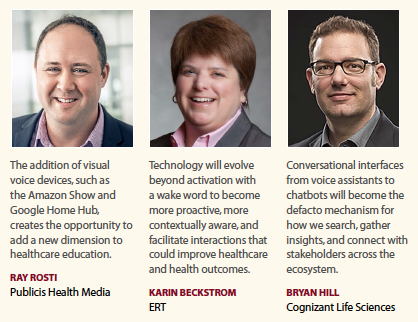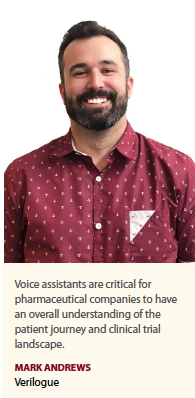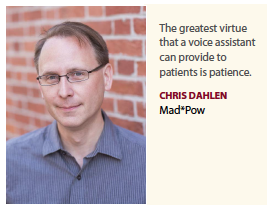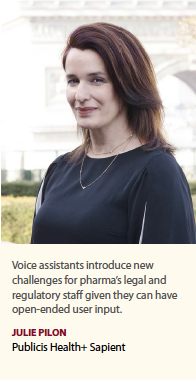Alexa, how will voice assistants impact the pharmaceutical commercial landscape in the next five years?
Alexa is “not sure about that," but our experts have the answers as smart speakers and voice technology begin to penetrate not only healthcare, but the pharma commercialization process as well.
Juniper Research predicts there will be 275 million voice assistant devices used to control smart homes by 2023. This is up from an estimated 25 million in 2018, a growth of 1,000%. According to DRG Digital, almost one-third of physicians are using Amazon Echo voice services or electronic health records with voice capabilities. According to data from NPR and Edison Research, one in six Americans now owns a voice-activated  speaker, up 128% just from January 2017. As reported in the Smart Audio Report, voice-driven devices have quickly become essential to many owners, with 42% of smart speaker owners saying their smart speakers are essential to everyday life.
speaker, up 128% just from January 2017. As reported in the Smart Audio Report, voice-driven devices have quickly become essential to many owners, with 42% of smart speaker owners saying their smart speakers are essential to everyday life.
Voice assistants are going to continue to gain tremendous ground and greatly impact the industry over the coming years for many reasons, but perhaps the most important one is: they are so easy for consumers to use. We all know how to use our voice to ask a question.
Voice assistants have the opportunity to change the pharmaceutical landscape especially in the areas of adherence and distance care, says Ray Rosti, executive VP, platform activation, Publicis Health Media. “The addition of visual voice devices, such as the Amazon Show and Google Home Hub, creates the opportunity to add a new dimension to education," Mr. Rosti says. “Pairing these connected devices with scheduled tasks and reminders enables care teams to track the adherence of patients and loved ones."
Google recently reported that 41% of people who own a voice-activated speaker say it feels like talking to a friend or another person. At a time when patients get very little time with a physician and leave the office and pharmacy with a handful of paper that they will never read, voice assistants have the opportunity to bolster patient education and health literacy.
Connected home devices, such as the Amazon Echo and Google Home, are setting the  stage for a new kind of computing: ambient computing — the backdrop of sensors, devices, intelligence, and agents that can put the Internet of Things to work.
stage for a new kind of computing: ambient computing — the backdrop of sensors, devices, intelligence, and agents that can put the Internet of Things to work.
“There is a very long road ahead to achieve a truly intuitive ambient computing world, but it is coming sooner than most people think," says Chris Cullmann, head of digital, Ogilvy Health. People who own voice assistant technology become quickly accustomed to asking for health advice. The behavior is internalized and quickly becomes routine and instinctive.
“It’s this routine, the aspect of expecting to interact with the personality built into the device, that is so critical to pharmaceutical manufacturers," Mr. Cullmann continues. “By adding assistance to patients and caregivers through skills, well-thought out search placements, and content, healthcare brands can borrow a lot of trust-equity afforded by the familiar voice assistant already in the home setting."
According to Bill Rogers, CEO at Orbita, interacting with a voice assistant gives patients a very natural way to become educated on their illness or condition. “A problem in healthcare in general is that a vast majority of people are not educated or informed and using natural language to interface with a smart speaker enables discussions on a particular topic, resulting in a better educated patient that leads to healthier patients, which lowers costs; so, there is a big, big benefit all around."
Voice assistants are not taking the place of people, he says, but rather are doing tasks that nobody was doing anyway. “There’s this void in care, and voice and chatbots can fill that void and enable patients to follow their treatment and care protocol right at the time they  need to," Mr. Rogers says.
need to," Mr. Rogers says.
As the use of voice assistance becomes ingrained in everyone’s daily rituals, its use will also spread to the healthcare side of our lives, says Karin Beckstrom, senior product manager, ERT. “Voice assistance itself will rapidly evolve over the next five years and, as a result, will become deeply embedded in our daily routines," Ms. Beckstrom says. “We can expect the technology to reach beyond activation with a wake word, to becoming more proactive, more contextually aware and facilitating interactions that could improve healthcare and health outcomes."
For example, she says, consider the role voice assistance (VA) could play as a health coach. Through the IoT, data from wearables, such as activity trackers that also monitor sleep patterns, could be integrated into VA applications. Imagine awaking to this conversation: “Your sleep data show you took a long time to fall asleep last night. Studies show reducing the blue color on your smartphone can improve time to sleep — would you like me to change the setting on your phone?"
“VA can be used for interventions, to prevent patients from forgetting medications and appointments, or for monitoring blood glucose and/or blood pressure as advised by a healthcare provider," Ms. Beckstrom says. “And let’s not forget its capacity for automatic trending, for example, ‘You walked 10% more this week than average. Good job.’ "
Leveraging the presence of VA smartly, brands can now participate in the morning routine, help guide behavior change through the day, and perhaps intervene in education. “More so, delivering healthcare information to patients through the spoken word now allows a greater opportunity to bridge low health literacy with authoritative disease education materials and curated actions that can provide care to patients in an intuitive way," Mr. Cullmann says. The voice assistant can also provide regular access to information in a central location and manage everything from dosing information and regimen to questions about access information.
Patients have been found to interact more readily with a voice assistant rather than a real person, perhaps because Alexa doesn’t make them feel awkward. Patients, especially the elderly and the disoriented, may struggle to remember which pills they have taken and when their dosage needs to be checked or changed. The array of providers and caregivers who encircle a patient can always be more helpful with a coordinated care plan to help track current prescriptions and dosages. A voice assistant can play the arbiter in these situations, providing a source of truth that the patient can check — again and again throughout the day, if necessary — to keep track of which medications are taken and provide a nudge or an alert if the patient falls behind. The information that drives the assistant can inform all of the other parties involved in the patient’s care on dosages and adherence.
“The greatest virtue that a voice assistant can provide is patience," says Chris Dahlen, senior VP, application development, Mad*Pow. “This basic, subservient role of answering questions again and again — and only for approved users — will provide the most value to patients and the people who support them, keeping even the most disoriented patients from falling off track with the many medications they rely on."
The impact of voice gets an extra boost when it is coupled with a device, such as an in-home companion robot that combines artificial intelligence with voice technology, like the Pillo robot.
The companion robot market is expected to top $34 billion by 2022, according to a 2017 P&S Market Research report. The report also noted that the global aging population has been driving personal robots markets in developed regions.
In collaboration with Orbita, Pillo Health developed the Pillo robot, which can be programmed to dispense medicine. It uses AI algorithms that proactively engage with patients, improve therapy adherence, and deliver personalized care for adults living with chronic conditions. The Pillo robot can accompany a patient at every point on his or her care journey. Mr. Rogers says this type of powerful tool is going to be revolutionary for the pharma industry, as it ensures the patient is taking his or her medication.
And pharma companies are not lagging behind on the emerging voice assistant trend. Companies such as Merck and Johnson & Johnson are creating ways to use voice assistants to help educate and motivate patients.
For example, Merck’s subsidiary StayWell is the type of innovation that will drive other companies forward. StayWell, a health empowerment company, developed StayWell Voice, an omnichannel application that uses voice-first technology and advanced analytics to help individuals manage their weight and stress, and take action on biometric values. StayWell Voice leverages the O Voice platform to power multi-modal creation and management of intelligent conversational applications for devices such as Amazon Echo and chatbots for mobile and web environments.
Merck also sponsored the Alexa Diabetes Challenge to generate solutions that can help patients manage the disease.
Additionally, last year, Novo Nordisk focused its 17th health innovation World Cup solely on voice-activated technology to improve diabetes care.
“We’re starting to see more projects from pharmaceutical companies that want to create a brand that can help and interact with patients," Mr. Rogers says.
Consumer adoption is driving the market, and with one in six people owning a smart speaker and nearly every smartphone, car, and IoT-enabled device having VA capability, conversational experiences are becoming the norm, says Bryan Hill, chief technology officer, Cognizant Life Sciences. “The behavioral data captured from these experiences will fuel the machine learning and cognitive capabilities required for more sophisticated  conversations that integrate a given voice assistant’s conversational knowledge from multiple sources and drive a dialogue."
conversations that integrate a given voice assistant’s conversational knowledge from multiple sources and drive a dialogue."
Much like the smartphone transformed the way we communicate and transact over the last 10 years, conversational interfaces from voice assistants to chatbots will become the defacto mechanism for how people can search, gather insights, and connect with stakeholders across the ecosystem, Mr. Hill adds.
Voice Assistants and Clinical Trials
Mr. Cullmann says voice technology is also very helpful in the complicated clinical trial space. A voice assistant can help patients navigate complicated location, audience, and eligibility information in addition to real-time enrollment information. By allowing for a plain-language interface to these services, the industry can reduce strain on trial locations and patient frustration, he says.
Just last year, Orbita and ERT partnered to research the potential of voice assistants to improve patient engagement and optimize data collection in the clinical trial setting.
Patients used their voice to complete interactive surveys, verify completion of care tasks and report health concerns while clinical trials investigators and coordinators use built-in analytics to track user engagement and respond to user input.
“There are many reasons voice can help out in clinical trials, and one of the main topics that comes up when talking to sponsors and patients is the capability to be a companion, someone who’s always there for patients," Ms. Beckstrom says. “The concept of bringing a clinical trial partner right into the home of the patient brings a powerful experience to that patient. Patients can ask questions and get guidance."
The biggest challenge in a clinical trial is to keep patients engaged and keep them adherent, and voice can lower some of the obstacles for patients to engage in clinical trials. “Any friction in the way to engage with that patient is a problem," Mr. Rogers says.
“Voice literally is the lowest interface for friction to be able to interact in an application."
All of these advances can ease participation in clinical trials by allowing VA to become a patient’s personal trial guide, automatically reminding them of tasks and appointments, passively collecting data from their smart speakers or sensors, and transmitting it to trial sponsors, as well as alerting the primary investigator of noteworthy or other safety-related information.
“Over time, the digital connectivity of patients through connected devices and biometric monitoring devices has the ability to provide meaningful data for other health-industry-related applications, such as identifying patients who are a potential fit for clinical trials," Mr. Rosti says.
“Any necessary data can be automatically sent to the FDA, alongside other test-based data that can be gathered by the patient," Mark Andrews, marketing manager, Verilogue says. “In this light, opportunities arise to perform a specific leg of qualitative research, cognitive linguistic interviewing, to judge and understand the patient engagement, emotions, and feelings in the exam room."
Voice Applications and Commercial Applications
Voice can also be very effective for the sales team. With more and more specialty and orphan drugs, the commercial model of large sales teams is changing. Also, more specialists with different skillsets need to call on and service many different customer stakeholders beyond the physician. “Voice assistants can be the front line to answer many questions and serve as a concierge to facilitate transactions and connections to the right resources within a pharma company," says Julie Pilon, chief strategy officer, Publicis Health+ Sapient.
Using an on-demand resource, an HCP doesn’t need to wait to get a question answered on the next medical or sales call. In addition, the voice assistant can get real-time insights into what questions and issues are on an individual’s mind, and service them through both digital and human interactions.
However, voice assistants introduce new challenges for pharma’s legal and regulatory staff given they can have open-ended user input, Ms. Pilon cautions.
“It’s important to work with the legal and regulatory teams and start with existing  submission formats for channels such as call scripts, SMS streams, and automated phone systems," she says.
submission formats for channels such as call scripts, SMS streams, and automated phone systems," she says.
The key to an effective and efficient review of this new experience is educating the legal and regulatory team on what the channel is and how it works. Additionally, the more companies can leverage the format of existing similar submissions and look to use as much content from the submissions as possible, the better, she adds.
Orbita is collaborating with Brigham and Women’s Hospital Digital Innovation Hub to advance the use of voice-enabled and conversational AI solutions in the hospital setting.
The organizations will collaborate on innovating digital healthcare applications that leverage voice assistants, chatbots, and other conversational user interfaces to improve patient engagement, remote care, clinical efficiency, and business processes.
Acceleration will happen once stakeholders recognize the promise that can be realized so quickly, and this will be proved through the success of ongoing projects such as the Brigham and Women’s Hospital initiative.
Mr. Rogers predicts that in just two to three years, both mobile apps and medical devices will move to voice applications. “This is a massive trend that’s moving the marketplace," he says. “It’s going to be a big, big, big fast wave that is going to affect everything."(PV)
~~~~~~~~~~~~~~~~~~~~~~~~~
How Consumers Used Voice Assistants for Healthcare
70% asked about symptoms they are experiencing
59% asked about health or diet tips
46% of people with voice assistants have used it for an issue concerning health or health care.
48% used it to connect to a hospital or doctor
41% used it to ask about health plans or insurance
When Voice Assistants Weren’t Used:
67% didn’t think to do so
25% didn’t feel secure
17% said needs were too
complicated
15% said they didn’t think there would be useful tasks for their
needs















